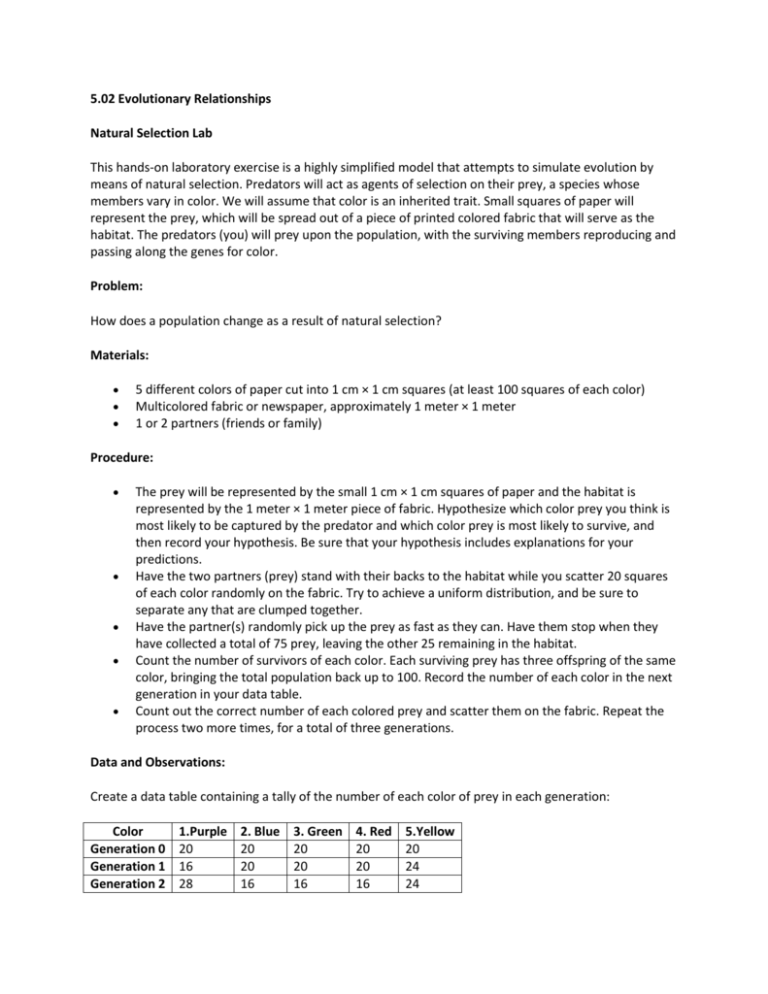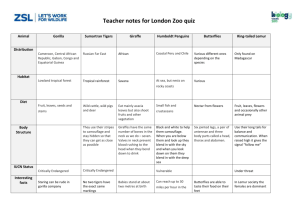5.02 Evolutionary Relationships
advertisement

5.02 Evolutionary Relationships Natural Selection Lab This hands-on laboratory exercise is a highly simplified model that attempts to simulate evolution by means of natural selection. Predators will act as agents of selection on their prey, a species whose members vary in color. We will assume that color is an inherited trait. Small squares of paper will represent the prey, which will be spread out of a piece of printed colored fabric that will serve as the habitat. The predators (you) will prey upon the population, with the surviving members reproducing and passing along the genes for color. Problem: How does a population change as a result of natural selection? Materials: 5 different colors of paper cut into 1 cm × 1 cm squares (at least 100 squares of each color) Multicolored fabric or newspaper, approximately 1 meter × 1 meter 1 or 2 partners (friends or family) Procedure: The prey will be represented by the small 1 cm × 1 cm squares of paper and the habitat is represented by the 1 meter × 1 meter piece of fabric. Hypothesize which color prey you think is most likely to be captured by the predator and which color prey is most likely to survive, and then record your hypothesis. Be sure that your hypothesis includes explanations for your predictions. Have the two partners (prey) stand with their backs to the habitat while you scatter 20 squares of each color randomly on the fabric. Try to achieve a uniform distribution, and be sure to separate any that are clumped together. Have the partner(s) randomly pick up the prey as fast as they can. Have them stop when they have collected a total of 75 prey, leaving the other 25 remaining in the habitat. Count the number of survivors of each color. Each surviving prey has three offspring of the same color, bringing the total population back up to 100. Record the number of each color in the next generation in your data table. Count out the correct number of each colored prey and scatter them on the fabric. Repeat the process two more times, for a total of three generations. Data and Observations: Create a data table containing a tally of the number of each color of prey in each generation: Color Generation 0 Generation 1 Generation 2 1.Purple 20 16 28 2. Blue 20 20 16 3. Green 20 20 16 4. Red 20 20 16 5.Yellow 20 24 24 Generation 3 40 4 11 24 20 Record any observations. Data Analysis: Chart Title Purple Blue Green Red Yellow 40 28 24 20 20 20 20 20 24 24 20 20 20 16 20 16 16 16 11 4 Generation 1 Generation 2 Generation 3 Generation 4 Conclusion: Be sure to answer the following reflection questions in the conclusion of your lab report: Reflection questions need to be answered using complete sentences. Some questions may require a longer explanation in paragraph form. How do the original and surviving prey populations compare? There were more purple and blue because of the camouflage. How did the colors of each type of prey affect its population size over time? The colors Green and Yellow both have a small population, while Blue and Purple dominated the ecosystem. What color(s) seemed to camouflage the best in this habitat? What color(s) seemed to stand out the most? The red color stood out the most, while blue and purple had more of a camouflage. How do you predict the data would change if you continued? Explain your answer. I believe that at some point, the color red will get extinct because of the blue and purple population. How would these results change if the colors or patterns of the habitat were to change? Even with a slight change, Blue and Purple would still dominate in the ecosystem. Though, if there was a drastic change, the color dominations might change. Identify at least two things that are unrealistic and two things that are realistic about this exercise. This exercise is realistic because the 2 people picked out random colors, like a predator would do, and some colors had less than others. What traits could help a predator be more “fit” in this model environment? Being strong, clever, and camouflaged. Describe other adaptations besides color that could affect an individual’s survival. Their cleverness, better running skills, and ability to hide and/or camouflage.







